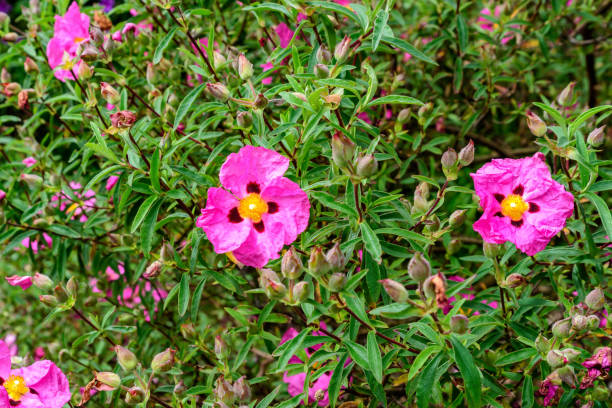Grey-leaved Rockrose - Cistus incanus

Common Names: Grey-leaved Rockrose, Cistus incanus, Cistus, Rockrose, Pink Rockrose, Rose of Sharon, Grey Cistus, Rose Cistus, Cistus villosus, Grey Rockrose, Mediterranean Rockrose, Labdanum, Cist (Latin origin), Róża skalna (Polish), Rugea skalní (Czech), Cisto (Italian/Spanish/Portuguese), Incense Rose
Latin Name: Cistus incanus
Origin: Asia, Europe
Short Introduction
The shrub is a moveable plant that thrives in sunny locations during the summer and should be brought indoors before the onset of winter frosts. It prefers full sun and moderately moist soil with higher magnesium content. The leaves typically remain on the plant in winter if temperatures stay above 0 °C.
Cistus prefers a humus-rich, light substrate with regular but moderate watering. Propagation is possible through cuttings or by sowing seeds.
The pharmacognostic parts used are the leaves and flowers, though the aerial parts, capsules, tinctures, and powder from the plant are also utilized. Most commonly, the crushed aerial parts—especially flowers and leaves—are used.
Detailed Description
A famed aromatic herb renowned for its antioxidant effects.
Botanical Information
The Grey-leaved Rockrose is a highly branched, wild-growing, perennial shrub featuring simple, opposite, glandular-hairy leaves. The leaves are ovate, elliptical or obovate, 1.5–7 cm long, often with rolled-under margins. The upper surface veination is sunken, while the underside is densely hairy and grey-green. The shrub typically grows 30–150 centimeters tall.
The strongly aromatic flowers of the Grey-leaved Rockrose are regular, five-parted, with numerous stamens and free petals displaying colors from pink to violet. The ovary is superior with five chambers. The fruit is an ovate, pointed capsule up to 10 mm long, accompanied by a persistent, closely held calyx.
Flowering occurs from April to June.
Origin and Distribution
The Grey-leaved Rockrose originated in Turkey but today is widespread throughout the Mediterranean region, except for France and the southern Iberian Peninsula.
Usage / Dosage
This highly valued and well-known plant is celebrated for its antioxidant properties. Mediterranean populations have used it for centuries, and it is still appreciated as an ornamental shrub. In temperate climates such as the Czech Republic, it can be cultivated as a potted or container plant.
The beneficial compounds in the Grey-leaved Rockrose support the immune system, with a notable advantage being its high polyphenol content. These substances help purify the body from toxins and actively boost the body's defenses. As a result, the plant demonstrates a significant antioxidant effect.
Numerous scientific studies have confirmed the antioxidant action using various extracts in laboratory tests.
Interestingly, extracts with high concentrations of gallic acid, ellagic acid, and punicalagin have been evaluated against viral infections such as herpes virus and SARS-CoV-2, as well as bacteria (Staphylococcus aureus and Escherichia coli), with very promising results indicating potential as an antimicrobial agent. While these studies were performed in vitro (on cell cultures), the findings are quite positive (Filippis et al., 2024).
Another study demonstrated an interesting effect of the herbal infusion—specifically, an improvement in lipid profiles among healthy volunteers (Kuchta et al., 2021).
The plant also contains high levels of magnesium, which may be used therapeutically for muscle cramps and sleep problems.
Traditional medicine
In Sardinia and Turkey, the shrub is used in folk medicine to address gastrointestinal problems. In Morocco, it’s consumed to stimulate appetite and as an aphrodisiac. In Spain, the herb is widely used in cosmetics, for the treatment of skin infections, and to support wound healing in dermatological practice.
Active Compounds
The most frequently mentioned medicinal compounds are polyphenols (including gallic acid, ellagic acid, ellagitannins, ethyl esters of specific molecules, etc.). Also present are catechins, tannins (in general), flavonols, diterpenes, and sesquiterpenes as important complex constituents.
The contained glycosides include kaempferol, quercetin, myricetin, apigenin and its derivatives, flavonols, proanthocyanidins, and phenolic acids. Leaves are also rich in monoterpenes, sesquiterpenes, and diterpenes.
Dosage
Infuse approximately 2–5 grams (1 tablespoon) of dried leaves in 250 ml of boiling water and let steep for 5–8 minutes. After a short resting period, the infusion may be sipped. Internally, a maximum of 3 teaspoons per day is recommended. Typically, a tea is made from the Grey-leaved Rockrose, which can be sweetened with honey or flavored with lemon. The infusion is very aromatic and robust in taste. In summer, it is refreshing when chilled with mint and ice cubes. For one cup, use 1–2 teaspoons of Cistus, cover with boiling water, and steep for 5–7 minutes before drinking.
For topical use, boil 10 grams of Grey-leaved Rockrose in 300 ml of water for up to 7 minutes, allow to stand for 10 minutes, and strain. This decoction can be sipped or applied as a wash or rinse.
